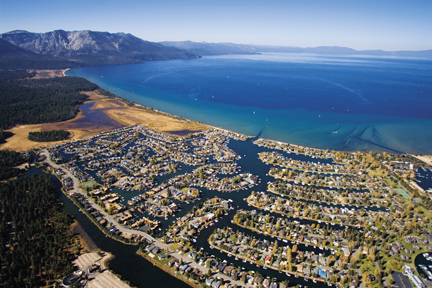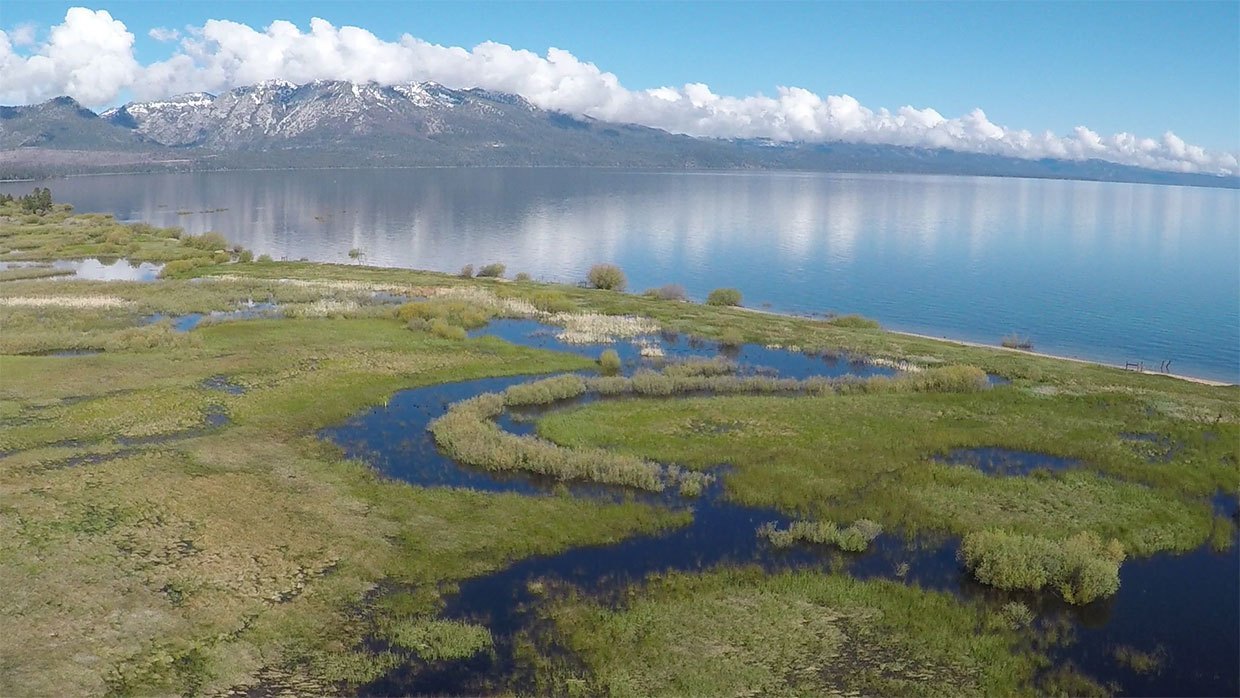
The development of the Tahoe Keys is a case study in how NOT to develop land in a fragile ecosystem on a world-renowned scenic lake. Now a proposal to manage the impacts from this bad decision is threatening to make matters worse.
Take Action Now to Save Lake Tahoe from Herbicides and Aquatic Invasive Weeds.
The Keys is a private residential development with 30 man-made lagoons plus two channels to the Lake, surrounded by houses, condominiums, boat docks, and a marina. This 1960s development destroyed the largest natural tributary wetland at Lake Tahoe, the Upper Truckee Marsh, through its dredging, filling and subsequent construction of houses and condominiums.
The Keys development destroyed the natural function and hydrology of the wetland. Now the legacy of this 50-year-old development is the largely stagnant artificial “lagoons” that provide boating access to the lake from the backyards of 1,529 homes and townhouses. The shallow lagoons are infested with invasive aquatic weeds, fed by decades of fertilizer use from the surrounding lawns, as well as the 169 storm water outlets from the surrounding community. The weeds’ explosive growth impedes navigation through the Keys. More importantly, boats owned by Keys residents transport weed fragments into the Lake, establishing weeds in other areas of Lake Tahoe, destroying Tahoe’s legendary water quality and clarity.
In 2018, the Tahoe Keys Property Owners Association (TKPOA) applied to the Lahontan Regional Water Quality Control Board (Lahontan) and the Tahoe Regional Planning Agency (TRPA) (Lead Agencies) to use herbicides to control the weeds in the Keys lagoons. However, herbicides will only address the symptoms stemming from the destruction of the wetlands; they will not address the underlying cause.
Aquatic herbicides have never been used in Lake Tahoe or the Keys, because the EPA prohibits their use in Tahoe, classified as Tier 3, Outstanding National Resource Water. TKPOA applied for a prohibition exemption along with other permits from the Lead Agencies, which led these agencies to release a Notice of Preparation (NOP) in June 2019, and a Draft Environmental Impact Statement and Environmental Impact Report (DEIS/DEIR), titled “Tahoe Keys Lagoons Aquatic Weed Control Methods Test,” on July 6, 2020.
The “Proposed Project” in the DEIS/DEIR would test the use of aquatic herbicides in the Keys lagoons that flow directly to Lake Tahoe along with non-herbicidal treatment.
Two other action alternatives are proposed:
- Action Alternative 1 (AA1) would test only non-herbicidal methods of aquatic weed control; the DEIS/DEIR identifies this alternative as the environmentally superior alternative.
- Action Alternative 2 (AA2) would dredge the organic material and sediment on the bottom of the lagoons to remove the roots and turions (buds) of aquatic weeds at three test sites in the Tahoe Keys lagoons, then replace the dredged material with a layer of coarser sand and gravel. Dredging would stir up aluminum sulfate in the sediments, which is extremely toxic to fish and other organisms in Lake Tahoe.
Your comments are urgently needed. Sign this petition today.
Sierra Club supports AA1, determined by the DEIS/DEIR as the environmentally superior alternative. Please submit your support for AA1. The deadline for electronic comments to tahoekeysweeds@trpa.org is September 3, 2020. Or sign the petition linked above and add your own comments.
To engage in virtual public meetings, visit this website: https://tahoekeysweeds.org/virtual-public-engagement-opportunities-due-to-covid-19/
Here are reasons why the Sierra Club strongly opposes the Proposed Project to use aquatic herbicides in the lagoons (and instead insists on non-herbicidal controls as in AA1):
- Applying aquatic herbicides is like applying a band-aid to a severed artery.The use of herbicides does not address the roots of the problem: decades of nutrient buildup from the heavily fertilized lawns in the Tahoe Keys, the numerous stormwater outfalls into the lagoons, and nutrient recycling from dead and dying weeds. Herbicides or not, weeds will continue to flourish under these conditions until the conditions supporting the infestations are removed.
- The Keys’ lagoons are hydrologically connected to Lake Tahoe, which is designated by the EPA to be a Tier 3, Outstanding National Resource Water (ONRW), referring to the adoption of the ONRW language in 40 CFR 131.12. This means its high water quality must be protected and maintained according to State and Federal anti-degradation regulations. In addition, Lahontan’s own Basin Plan requires that failure of all non-chemical methods must be demonstrated prior to authorizing the use of herbicides. TKPOA has not sufficiently tested non-herbicidal treatment methods, and it certainly has not met this prohibition exemption requirement of demonstrating the ineffectiveness of non-herbicide treatment methods, but instead continues pursuing herbicide use.
- The TRPA and Lahontan Water Quality Board have not yet provided an Anti-Degredation Analysis promised in the Notice of Preparation.
- Perhaps most important, experience in other lakes throughout the country indicates that aquatic herbicides require repeated applications because the herbicides fail to completely kill the weeds, particularly their seeds and roots. Thus, herbicide application would be required in perpetuity and inevitably lead to herbicide use throughout the lake. By allowing the agencies the opportunity to overcome the non-degradation regulatory hurdles, the Proposed Project, if it is allowed, would be “a foot in the door” for herbicide use throughout the lake with no time limits established.
- The Lead Agencies assert that the aquatic herbicides are safe because they have been approved by the EPA. However, the EPA has long asserted that Roundup and other pesticides are safe. Would you want Roundup poured into Lake Tahoe?
- The lack of realistic alternatives to the use of herbicides is contrary to the intent of both National Environmental Policy Act and the California Environmental Quality Act.
- The Proposed Project does not fully explore the full range of options, only aquatic herbicides and a few non-chemical methods. If we want to rid Lake Tahoe of weeds, we must expand our options.
- The Proposed Project only proposes to reduce the height of the invasive weeds by about 3 feet from the surface to provide weed-free navigation for boat travel. It never proposes to solve the problem of perpetual weed growth.
- Dredging the organic material and sediments, proposed by AA2, is not a realistic option because aluminum sulfate was dumped in the lagoons to settle the suspended sediments when the lagoons were built. Aluminum sulfate is extremely toxic to fish and other organisms in Lake Tahoe. Therefore, both the Proposed Project and AA2 propose control methods that would release toxic substances into lake water and should be strongly opposed.
It's time to restore the wetlands

Returning the Keys lagoons to a healthy functioning wetland would solve the weed problem (by eliminating the weed’s habitat, as even admitted to in the DEIS/DEIR). It would eliminate the need for herbicides. The wetland would filter nutrients and pollution from Tahoe, immediately improving the water quality and clarity of our cherished Lake Tahoe. Shown above, a healthy section of Upper Truckee River marsh. Done well, it could enhance the Tahoe Basin's health, beauty and quality of life, while preserving property values.
In addition to reducing the growth and spread of the weeds through non-chemical methods, the Lead Agencies should begin addressing the long-term problem by restoring some or all of the lagoons to marsh habitat.
In Sierra Club’s comments to the NOP, we requested this option be considered and thoroughly examined in the DEIS/DEIR, but it was rejected because it “didn’t meet the goals and objectives” of the project, which was to “test” various control methods.
What is more important? Managing the weeds for the convenience of boaters, or protecting Lake Tahoe's world-famous clarity, majestic color, and purity?
The time has come for the past destruction of marsh habitat to be healed. The time has come to restore a natural marsh, thereby permanently eliminating the invasive weeds, burying the years of nutrient buildup in the Keys, and providing filtration for new sources of nutrients and other pollutants into the Keys. Restoring to marsh some or all of the stagnant lagoons would also provide natural habitat for birds and other wildlife and could be done in a way to increase property values, beauty and quality of life. In the meantime, the Keys should test only with non-chemical methods as proposed in AA1.
In the short term, the Lead Agencies should consider protecting Lake Tahoe by installing a physical barrier, adjustable for snowmelt and stormwater events, between the Keys and the Lake. The barrier would remain in place until the weed infestation is completely removed.
We should not allow Lake Tahoe’s legendary water quality and clarity to be compromised by aquatic herbicides to suit the convenience of Tahoe Keys property owners.
In addition to the Lead Agencies bending at the will of the TKPOA with the DEIS/DEIR, the cost of this DEIS/DEIR and its “tests” are being paid for by the taxpayers. Why should the public have to pay tens of millions of dollars, with no end in sight, AND pay to support the convenience of a privileged few at the Keys, the majority of whom are second-home owners? Instead of providing boat access from their backyards for 3-4 months of the year, it's time to solve the weed problem at the Keys by restoring it to marsh.
Lake Tahoe deserves careful, considered, high-quality management and real solutions, not band-aids like the Proposed Project. Lake Tahoe is not a chemical testing ground, and applying a band-aid to a severed artery is not a solution. The health of our precious Lake Tahoe comes first. Allowing the use of aquatic herbicides without due exploration of alternatives, such as restoration, and thoroughly testing non-chemical methods first would be a dereliction of our duty to protect this national treasure.
Say no to Herbicides and Aquatic Weeds at Lake Tahoe. Sign this petition today!